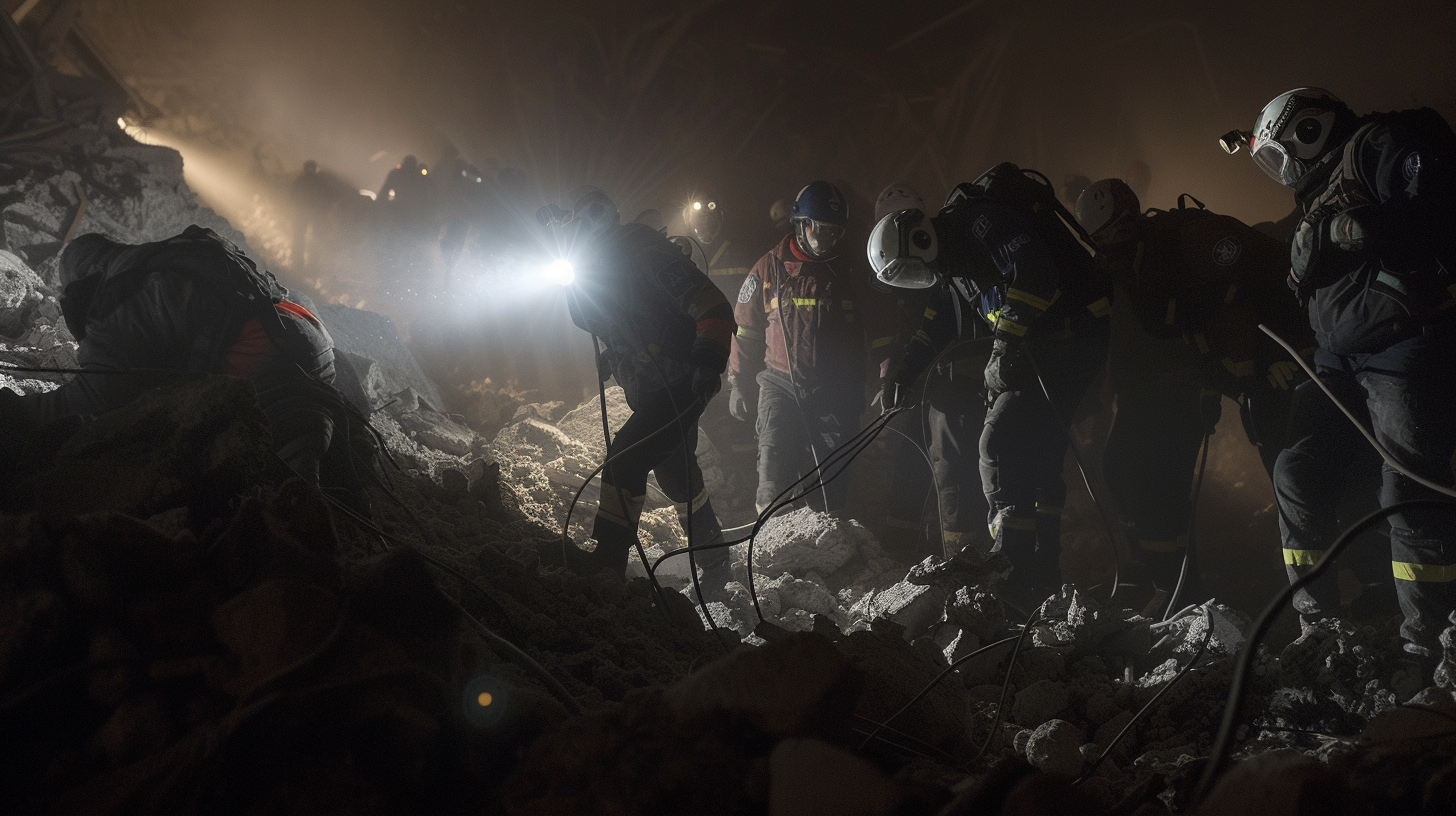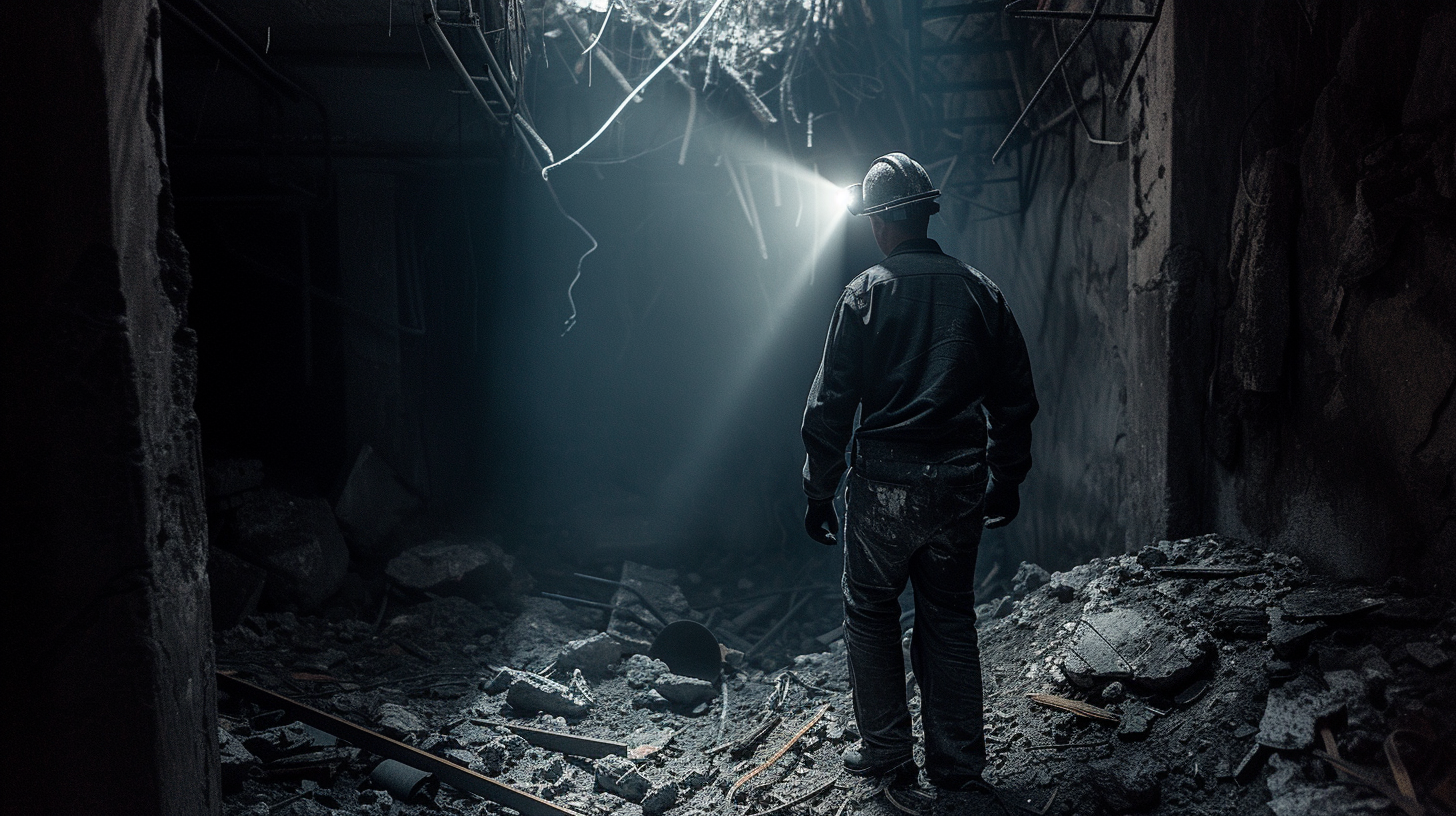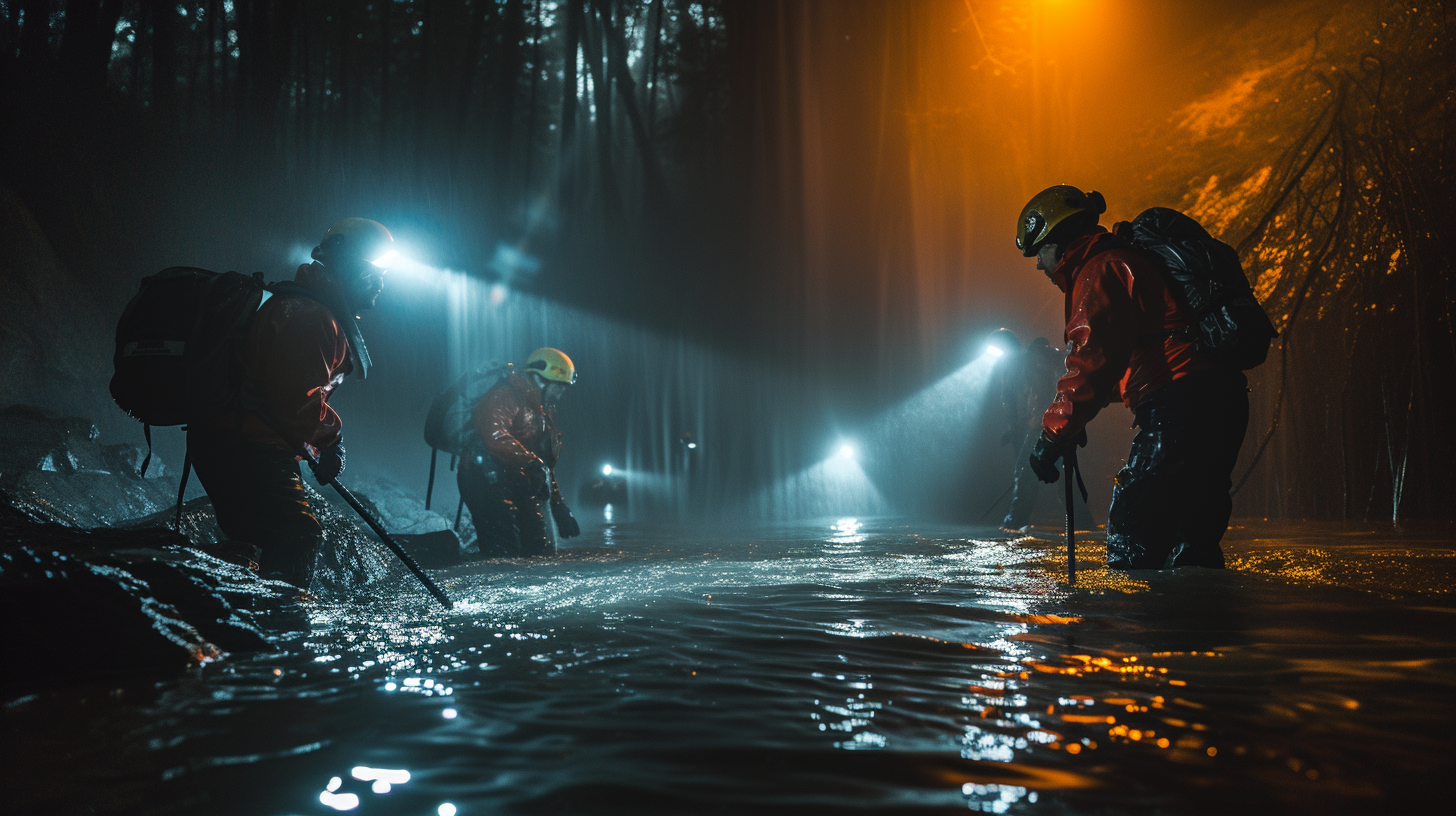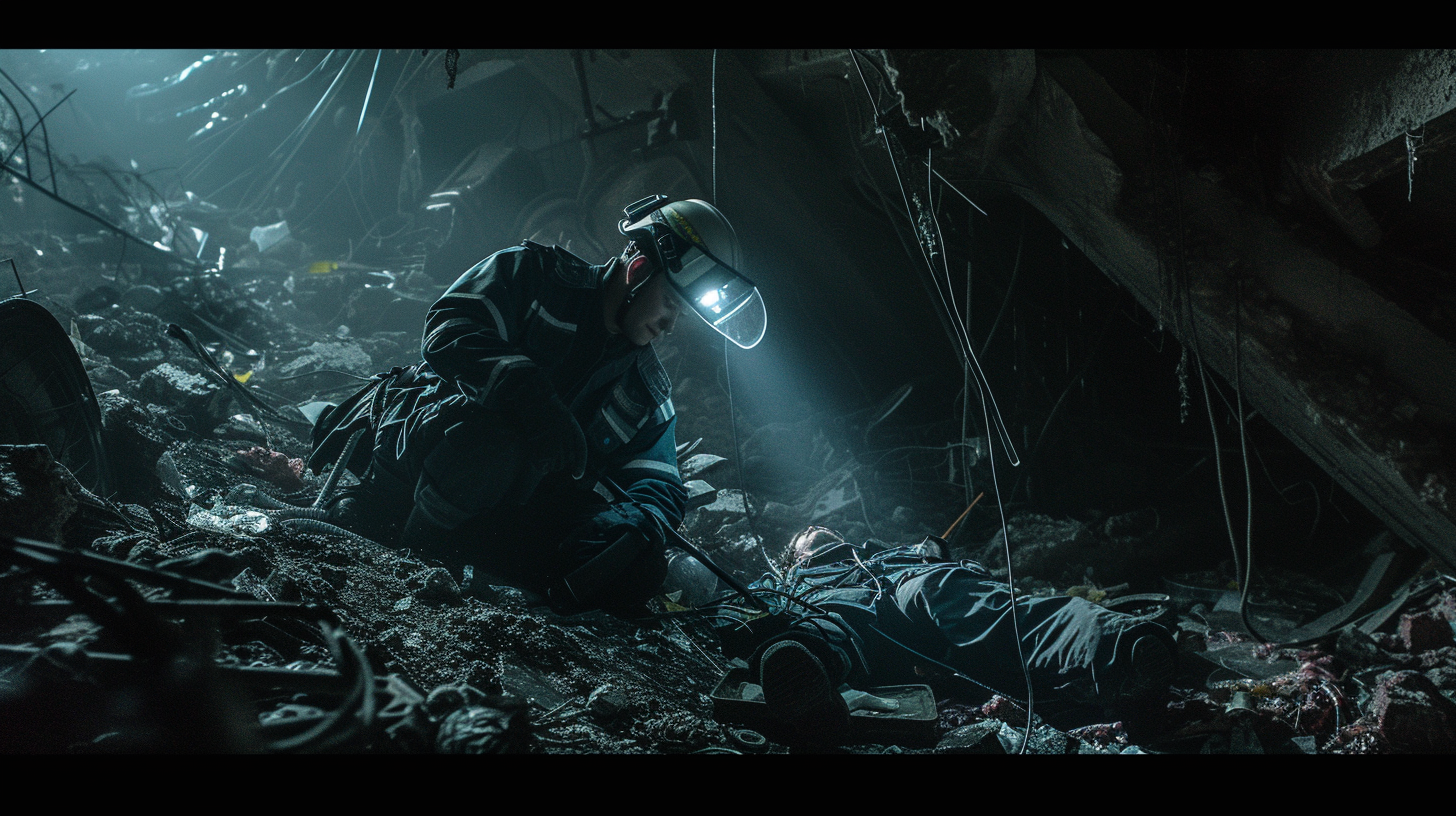In times of unexpected challenges, the value of being hands-free cannot be overstated, and that’s where headlamps come into play. As you navigate the complexities of disaster scenarios, from the darkness of power outages to the confines of collapsed structures, having both hands available for balance, medical aid, or debris removal becomes a non-negotiable necessity.
Headlamps, by casting light directly where your gaze falls, significantly reduce the risk of trips, falls, and other accidents, ensuring that you can move swiftly and safely. They also play a crucial role in task accuracy, whether you’re administering first aid or signaling for help.
But beyond these immediate benefits, there’s a deeper layer to consider about how these devices not only illuminate paths but also facilitate better communication and coordination in high-stress environments. To uncover the full spectrum of how headlamps can truly transform mobility in disaster situations, one must explore further into their strategic application and integration into emergency response protocols.
Key Takeaways
- Headlamps provide reliable lighting during power outages, enhancing mobility in disaster situations.
- Hands-free operation allows for multitasking and better coordination, improving overall mobility.
- Headlamps aid in navigating through disaster-stricken areas by providing clear visibility and helping to identify hazards.
- Adaptive headlights enhance the ability to respond quickly in emergencies, ensuring safe navigation and facilitating faster response times.
Essential PPE in Disasters
In disaster situations, headlamps emerge as a critical piece of personal protective equipment (PPE), illuminating your path and keeping your hands free for urgent tasks. Whether you’re navigating through the aftermath of a natural disaster or responding to an emergency, the importance of having adequate lighting can’t be overstated.
For emergency responders working in conditions where power outages are common, headlamps provide a reliable source of light, enabling them to move swiftly and safely.
Headlamps aren’t just about seeing where you’re going; they’re also about preventing accidents. In environments where trips and falls can have serious consequences, the hands-free operation of headlamps allows you to focus on the task at hand, enhancing both your safety and efficiency.
Moreover, the ability to communicate effectively is vital in disaster situations. Headlamps facilitate better communication among team members, ensuring that everyone is on the same page during critical moments.
Given the unpredictable nature of disaster scenarios, having a headlamp as part of your PPE kit ensures you’re prepared for any situation. It’s not just about having light; it’s about having the right kind of light to navigate through challenges safely and effectively.
Preventing Trips and Falls
When you’re navigating through dark, disaster-stricken areas, enhancing nighttime visibility is key to your safety. Headlamps play a crucial role in mitigating obstacle risks, allowing you to see and avoid potential hazards that could cause trips and falls.
Enhancing Nighttime Visibility
To prevent trips and falls during disaster situations, headlamps significantly enhance nighttime visibility by offering hands-free operation. They’re crucial for illumination during power outages, ensuring you can navigate safely without holding a light source. This advantage is invaluable, especially when you need both hands for other tasks or when managing emergency response efforts.
| Benefits of Headlamps | How They Help |
|---|---|
| Hands-free operation | Allows for multitasking and better coordination during rescue operations. |
| Adaptive headlights | Automatically adjust brightness based on surroundings, reducing the risk of accidents. |
| Improved communication | Facilitates better interaction among team members in dark conditions, enhancing overall safety and productivity. |
Headlamps are not just about seeing but being seen, making them indispensable in ensuring your movement is safe and efficient during disaster scenarios.
Mitigating Obstacle Risks
Navigating through disaster-stricken areas, you’ll find headlamps invaluable for mitigating obstacle risks and preventing trips and falls. Their hands-free operation ensures you’re always prepared to face potential obstacles, providing clear visibility and aiding in identifying hazards.
Here are key ways headlamps enhance safety:
- Use in confined spaces: Improves navigation where fixed lighting is absent.
- Intrinsically safe designs: Suitable for hazardous locations, reducing risk.
- Attachment options: Securely fastens to hard hats and safety helmets, keeping paths visible.
- Rear-facing beacon lights: Alerts others to your presence, preventing collisions.
Equipped with a headlamp, you’re better positioned to move safely, avoiding hazards that could lead to injury, ensuring you stay on your feet when it matters most.
Enhanced Task Accuracy
When you’re faced with an emergency, improving precision under pressure is key, and that’s where headlamps shine. They allow you to navigate through debris with ease, ensuring you can move quickly without sacrificing accuracy.
Additionally, the support for quick decision-making that headlamps provide can be a game-changer in high-stakes situations.
Improving Precision Under Pressure
In disaster situations, adaptive headlights are crucial for improving your ability to see clearly and navigate safely, enhancing precision under pressure. These advanced lighting systems play a significant role for emergency response teams, particularly during search and rescue operations, by providing immediate illumination where it’s most needed.
Here’s how they make a difference:
- They adjust to illuminate curved roads and hills, reducing the risk of accidents.
- By responding to steering, they aid in accurate navigation through debris-filled paths.
- Electronic sensors swivel the headlights based on steering angle, ensuring no critical detail is missed.
- Automatic high beams activate in low visibility situations, allowing responders to spot hard-to-see objects quickly.
Adaptive headlights, therefore, aren’t just about seeing better—they’re about performing better when every second counts.
Navigating Debris With Ease
How can adaptive headlights transform your ability to maneuver through debris with unparalleled accuracy?
By adjusting in response to steering, these headlights illuminate dark, curved roads and the unforeseen obstacles they harbor.
Adaptive headlights, especially those utilizing LED lighting, ensure you’re not just reacting to obstacles but proactively navigating through them.
LED lighting ensures bright, clear visibility, making hard-to-see objects stand out faster than ever before.
This technology significantly enhances safety, ensuring continuous, adequate illumination around corners, thanks to the headlights’ ability to pivot up to 15 degrees.
Whether you’re dealing with the aftermath of a storm or navigating through an unfamiliar, treacherous path, adaptive headlights equipped with automatic high beams switch optimally between brightness levels, ensuring you can focus on moving forward safely.
Quick Decision-Making Support
Adapting to the unpredictable conditions of disaster scenarios, adaptive headlights not only illuminate your path but also support quick decision-making with enhanced task accuracy. These innovative lighting solutions automatically adjust, ensuring you’re always equipped with optimal visibility.
This is crucial for:
- Navigating safely through debris-laden roads
- Ensuring effective communication with rescue teams in low-light conditions
- Facilitating a faster response to rapidly changing situations
- Helping guide individuals to safety by clearly illuminating paths and exits
Adaptive headlights, with their ability to adjust based on steering input and speed, play a pivotal role in disaster situations. They ensure that you’re not just reacting to the conditions, but proactively making decisions that could save lives, all thanks to clearer, more accurate visual information.
Quicker Emergency Responses

Adaptive headlights significantly enhance your ability to respond quickly in emergency situations by illuminating the road more effectively. With the integration of LED technology in emergency vehicles and personal cars, you’re able to see and react to obstacles much faster. This advancement in lighting during disasters is not just about visibility; it’s about making each second count.
Here’s how adaptive headlights improve response times:
| Feature | Benefit | Impact on Response Times |
|---|---|---|
| Swivel Mechanism | Follows steering direction | Quicker identification of hazards |
| Automatic High Beams | Adjusts to conditions | Reduces reaction time to changes |
| LED Technology | Brighter, more focused light | Enhances visibility, shortens response |
These headlights, equipped with electronic sensors, adjust based on the car’s steering angle, ensuring that the path ahead is always well-lit. This is crucial on dark, curved roads and over hills where standard headlights fall short. The difference in how quickly drivers using adaptive lighting can spot hard-to-see objects versus those with traditional headlights is substantial, leading to faster, safer reactions in emergencies. Whether you’re navigating through a natural disaster or responding to an accident, the improved lighting in disaster scenarios offered by adaptive headlights can be a game-changer, significantly affecting overall response times.
Hands-Free Operation Benefits
In emergency situations, the ability to operate hands-free can significantly enhance your efficiency and safety. When disaster strikes, every second counts. Being able to use both hands without the burden of holding a light source can make a significant difference in your response time and effectiveness. Hands-free operation, a key feature of headlamps, emerges as a game-changer in disaster preparedness efforts.
The benefits of hands-free operation in disaster situations include:
- Enhanced productivity: You’re able to perform tasks more efficiently and safely, as you can use both hands without being hindered by a handheld light.
- Precision in tasks: Headlamps with hands-free operation are invaluable in situations that require detailed work, allowing you to focus on the task with precision.
- Improved team coordination: Hands-free operation facilitates better communication and coordination among team members during complex operations.
- Adaptability: Many headlamps allow you to adjust settings without manual handling. LED lights offer various levels of brightness and focus, ensuring you can adapt to any situation with ease.
Headlights that adjust automatically and LED lights that offer superior illumination are just a few examples of how hands-free operation can support your disaster preparedness efforts, keeping you safer and more effective when it matters most.
Facilitating Better Communication
Better communication is crucial during emergency situations, and adaptive headlights play a key role in ensuring you’re always aware of your surroundings. These advanced lighting systems adjust their beam direction based on your vehicle’s steering and speed, significantly enhancing your ability to see and react to obstacles or hazards on dark, curved roads, or over hills.
This improved visibility plays a crucial role in not just navigating through difficult terrains but also in signaling to others your intended path, facilitating non-verbal communication among drivers and rescuers in disaster scenarios.
Moreover, adaptive headlights, equipped with electronic sensors, swivel in alignment with your car’s steering angle. This capability allows them to better illuminate the driving environment, ensuring that hard-to-see objects are spotted sooner than they’d be with standard headlights. These systems often include an auto-dimming feature to prevent blinding oncoming traffic, further enhancing safety for everyone on the road.
Automatic high beams, a feature within many adaptive headlight systems, toggle between high and low settings based on the conditions, providing optimal lighting without manual input. This automatic adjustment is essential in emergency situations, where every second counts, ensuring that your focus remains on navigating safely through the disaster.
OSHA’s Headlamp Safety Guidelines
To ensure your safety during disaster scenarios, it’s crucial to familiarize yourself with OSHA’s headlamp safety guidelines. These guidelines are designed to maximize both your safety and the effectiveness of your headlamp in providing emergency lighting.
Here’s a concise overview to keep in mind for disaster preparedness:
- Ensure headlamps are properly rated for the environment: Make sure your headlamp meets OSHA’s standards for environmental hazards, including water and dust resistance.
- Regular inspection and maintenance: Before any disaster strikes, inspect your headlamp for damage and perform any necessary maintenance. OSHA emphasizes the importance of keeping emergency lighting in working order.
- Adequate brightness and battery life: Your headlamp should provide sufficient brightness for navigating obstacles and have a battery life that lasts through the duration of a potential emergency situation.
- Training on proper use: Familiarize yourself with how to adjust settings like brightness and beam direction. OSHA suggests that effective disaster preparedness includes knowing how to use your equipment properly.
Adhering to OSHA’s headlamp safety guidelines is a vital step in ensuring you’re prepared for any disaster scenario. By choosing the right equipment and knowing how to use it, you’re significantly improving your mobility and safety during emergencies.
Selecting the Right Headlamp

Understanding OSHA’s headlamp safety guidelines equips you with the knowledge for emergency preparedness; now let’s focus on how to pick the headlamp that best suits your needs.
When selecting a headlamp, consider its intended use—be it for work, outdoor activities, or in emergency situations. LED headlamps are a great choice, providing reliable illumination during power outages or in areas where natural light is scarce.
Evaluate the brightness and beam distance of the headlamp to ensure it meets your specific visibility and coverage needs. Look for models with adjustable brightness levels, allowing you to tailor the light intensity according to the task at hand or the environment you’re in. This flexibility is crucial in managing power efficiently and ensuring that you have light when you need it most.
Comfort and durability are also key factors. A lightweight headlamp with a soft, adjustable headband can make a significant difference in wearability over extended periods. Water resistance is another important feature, ensuring your headlamp can withstand harsh weather conditions.
Safety Beacon Lights Importance
In the realm of disaster preparedness, the significance of safety beacon lights can’t be overstated, as they play a crucial role in enhancing visibility under adverse conditions. These lights aren’t just add-ons; they’re essential tools that ensure you and others can navigate safely through public spaces when the unexpected strikes.
Emergency lighting, especially beacon safety lights, are pivotal for several reasons:
- Enhancing visibility: They cut through the darkness and adverse weather, ensuring everyone can see and be seen. This is critical in avoiding accidents and ensuring smooth evacuations.
- Creating a 360-degree radius of visibility: Rear-facing beacon lights ensure you’re visible from all angles, significantly reducing the risk of collisions or getting lost during chaos.
- Minimizing panic and confusion: In disaster situations, clear, visible guidance can calm nerves and facilitate orderly movement, making beacon lights indispensable in public spaces.
- Deterrence against criminal activities: Lights act as a deterrent to looting, vandalism, and other crimes by maintaining visibility even during power outages, thus enhancing safety and security.
Conclusion
In conclusion, headlamps are vital in boosting your mobility during disaster scenarios. They prevent trips and falls, enhance task accuracy, and ensure quicker emergency responses.
By offering hands-free operation, headlamps allow you to focus better and communicate more effectively. It’s crucial to follow OSHA’s safety guidelines and select the right headlamp, including those with safety beacon lights, to maximize your safety and efficiency.
Embrace headlamps as an essential part of your disaster preparedness kit to navigate challenging environments with confidence.




